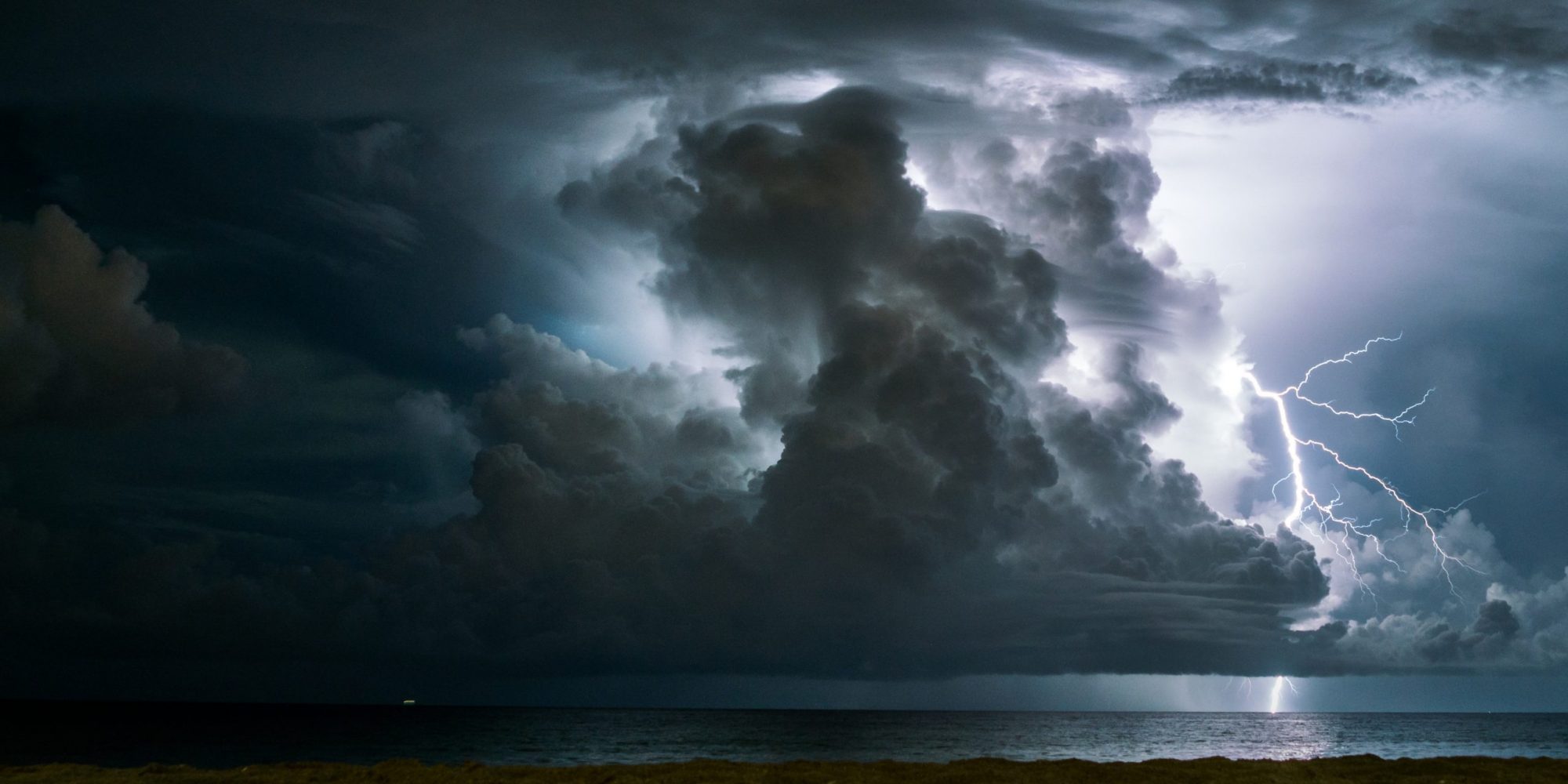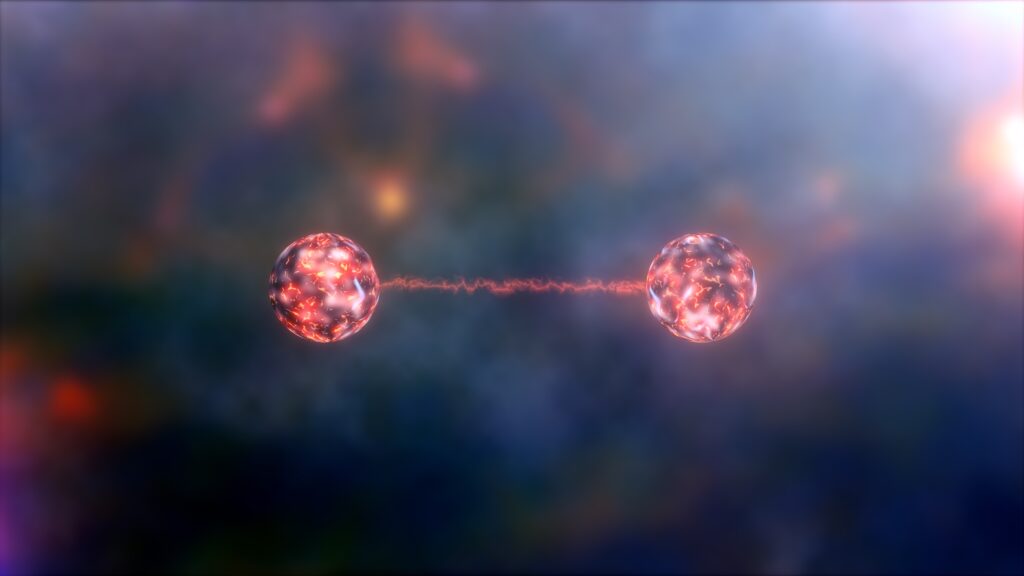Conscious storms and the origin of life
Reading | Philosophy | 2021-12-26

This surprisingly coherent and empirically well-grounded essay argues that, although governed by blind, purposeless laws of nature, the Earth’s atmosphere—just like biological brains—may be associated with a subjective first-person perspective, and may have therefore purposely created life on Earth. The essay coherently brings together a compatibilist approach to free will, an idealist metaphysics and speculations about abiogenesis.
The mind-body problem is typically thought to concern the relation between mind and brain in humans and perhaps other animals. However, Thomas Nagel—in his famous and criticized book Mind and Cosmos (Nagel, 2012)—wishes to show that “the mind-body problem is not simply a localized problem that affects the relationship between mind and brain in living animal organisms, but rather it pervades our understanding of the whole cosmos and its story.” Although we—like many other authors—remain skeptical of Nagel’s ill-defined natural finalism, we too do believe that the gravity of the mind-body problem is currently underestimated. In this essay, we will follow a completely different approach with respect to Nagel’s one.
The purpose of this essay is to show that the mind-body problem does not only concern the relationship between mind and brain in humans and other animals, but rather affects the current neo-Darwinian conception of the whole phenomenon of life.
The Neo-Darwinist thesis is typically the following: although living organisms seem, prima facie, to be the product of a creative mind, given that a naturalistic explanation for the origin of life has been found or can be found in principle, life is not what it appears to be; i.e. it is not the product of a creative mind. In The Blind Watchmaker (Dawkins, 1986) Richard Dawkins clearly states that life is, instead, the result of a blind and unconscious process. With the term ‘blind’ he basically means that the process is ‘purposeless’, and with the term ‘unconscious’ he really means that there was no mind that intentionally created living organisms.
We believe that these conclusions are somewhat hasty and drawn without observance of the current debate on the mind-body problem. Consider, in this regard, that the present essay also gives the strong impression of being the product of a mind. Yet, there is certainly a naturalistic explanation for its appearance, given that the brains of its two authors operate according to the laws of physics. The laws of nature, including the neuronal electrochemistry that regulates our brains, are by definition purposeless: opposite electric charges tend to attract each other without any purpose. Yet, in the second paragraph of this essay you have read the words: “The purpose of this essay is to…”. This is one of the most fascinating aspects of the mysterious relationship between mind and matter: although neuronal discharges simply happen by virtue of purposeless laws of nature—just as e.g. lightning in the sky—corresponding to the activity of these discharges there are mental contents experienced from the first-person perspective. Among these contents there is the belief that what is happening in nature (the writing of this essay) is not simply happening without purpose, but instead results from our free will. Therefore, the existence of a description of a process, in physical terms, as the ‘blind’ (i.e. purposeless) unfolding of natural laws does not exclude the conscious experience of a creative, purposeful act. Consequently, the fact that a naturalistic explanation for the appearance of living beings exists (or at least can exist) does not necessarily support the thesis that living beings appear by virtue of a ‘blind’ and ‘unconscious’ process. Just as we, the authors of the present essay, experienced its creation as a purposeful process, so may nature experience the creation of living organisms, according to its own laws, as a purposeful process as well.
So let’s consider the classic story we learned in school books about the origins of life on Earth. The story typically emphasizes the central role of lightning in the causal chain that led to the emergence of the first living organisms. The idea arose from the famous Miller-Urey experiment, in which electrical discharges simulated lightning strikes in the primordial atmosphere. Lightning discharges happen in the sky just as neuronal discharges happen in our brain, and they are both phenomena involving electromagnetic interactions. The question we pose is therefore the following: is it possible that, on the primordial Earth, the purposeless activity of lightning discharges was associated with a conscious experience of purposeful creation? If so, the creator could be identified with our own planet, and its brain with the Earth’s atmospheric system. As bizarre as this hypothesis may seem, we cannot exclude that there is conscious experience associated with any physical phenomenon, for we have no idea of how or why conscious experience accompanies the activity of a biological brain in the first place.
The generic nature of such an answer may leave one unsatisfied. However, the appearance of life on Earth as the product of a mind is at least as plausible as the other known hypotheses. Such a hypothesis—which, like the others, makes no claim to have been proven—has an epistemological advantage over the others: it describes living organisms exactly as what they appear to be, i.e. the product of a mind.
In this regard, let’s consider C. R. Woese’s theory, according to which it is far more likely that life originated from a prebiotic medium that is intrinsically ‘cellular.’ The best candidate for this medium is given by atmospheric clouds made up of water droplets whose size is typically tens of micrometers, thus comparable with the size of living cells. Furthermore, the formation of amphiphilic double-layer membranes—think of soap-bubbles—can occur around these droplets, so a primordial cellular membrane can spontaneously form. The forces acting on these microsystems go beyond just gravity and winds, because of the presence of generally non-uniform electric fields in clouds. The dimensions of the droplets are precisely those for which dielectrophoretic forces become important, whereas for smaller dimensions Brownian motion dominates and for larger dimensions gravity dominates. The clouds’ electric fields reach values in the order of 10-100kV/m, which are consistent with the values involved in everyday dielectrophoresis techniques at submillimeter scales. Such techniques are useful in many fields because of their high selective power. Therefore, such forces can have the same selective action in clouds.
These considerations serve to further underline the possible causal power of the entire atmospheric system on the appearance of the first living organisms, admitting that by virtue of the forces that the entire atmospheric system exerts on its microdroplets the first living organisms could at some point appear on the primordial Earth.
It must be admitted that no one is currently able to reproduce this process, i.e. nobody is currently able to create life from chemicals. But when we succeed in doing so, we should admit that life will have been created again in a way similar to how it was created about 4 billion years ago on our planet: a living organism appeared by virtue of blind (purposeless) electromagnetic forces that regulated the creative, conscious activity of something akin to a non-biological brain. This creative consciousness would have been aware of what it was doing, fully living the creative experience. It would have believed, from a first-person perspective, to be the intentional creator of a form of life. Corresponding to the blind forces that operated on its brain—in the third-person perspective—there would have been a conscious experience—in the first-person perspective—of a creative process.
As we have already argued, since we have no idea of why there is conscious experience corresponding to the activity of a particular physical system (biological brains), we have no way of refuting the hypothesis that there was conscious experience associated with the electromagnetic activity of the primordial atmospheric system. And since we have no idea of what is so special about a biological brain, we are forced to formulate the following conjecture: if a system has similar physical or structural characteristics to those of a biological brain, then it is plausible that its activity is associated with conscious experience. Such a conjecture is based on the observation that my brain and your brain are different but quite similar in many ways, and we are both conscious.
So let’s see what characteristics are common to a biological brain and the Earth’s atmosphere, based on a long tradition of comparative studies between the two, aimed at determining possible interactions between environmental electromagnetism and brain activity. Both the brain and the atmosphere are self-organizing, complex, non-isolated systems at thermodynamical disequilibrium. The main constituent of both is water, and both have a cellular structure at the lowest organization level: in the scenario we have referred to for the origin of life, cloud water droplets are the most ancient ancestors of living cells, and therefore also of neurons. Regarding the global organization of the two systems, at the highest level the atmospheric system, like the brain, is organized in two hemispheres. The two hemispheres are characterized by opposite values of Coriolis force resulting from opposite latitudinal motion. Independently of the physical reason for such an organization, let’s just note that the brain and the atmospheric system share a bilateral symmetry.
Furthermore, in these two non-isolated systems the free-energy—which for both systems ultimately comes from the Sun—is involved in establishing electromagnetic potential differences across the membrane of each cell. In the case of the brain, the electrochemical membrane potential is maintained by virtue of the action of the ATP-dependent Na-K pump. In the atmospheric system, the free energy absorbed by the Earth is stored in differences of electric potential within clouds, between clouds, between clouds and the surrounding air, and between clouds and the ground. Regardless of the specific charge separation mechanism, because of the cellular structure of each cloud, it is likely that an electric potential gradient is present across the surfaces of the cells of the system, which can generally consist of liquid water droplets or frozen water crystals. For both systems, the free energy absorbed and stored in such potential gradients is dissipated in the process of electric discharge, which consists of an electrostatic discharge for the atmospheric system and of an electrochemical discharge for the brain.
Cloud charging is the phenomenon responsible for lightning events. The physical mechanism through which a lightning discharge begins is the so called ‘stepped leader,’ which is constituted by a channel of free electrons typically branching in a tree-like configuration. When the stepped leader approaches the positively charged region of the cloud, its relatively large negative charge sets the condition for the ‘return stroke,’ a large flow of positively charged ions from the positive region to the negative region of the cloud. Persinger (Persinger, 2012) compared conduction in a neuronal axon with the stepped leader. He recognized similar wave shape characteristics between neuronal action potential and lightning discharge, as well as the coincidence of different physical quantities, such as the power and current densities of the respective discharges. Moreover, once a lightning discharge has occurred, if additional negative charge is shortly made available to the upper portion of the previous stroke channel, a train of impulses can be produced. Similarly, trains of impulses in synchronously firing neurons generally occur in a brain.
At this point, it is natural to question whether different atmospheric discharges can be related events, just as distinct synchronous discharges of neuronal clusters are related in a brain. In other words, we are asking whether the atmospheric system can be regarded as a computing machine, a neuronal network of some kind. In this regard, while an enormous amount of study has been devoted to the initiation of a single lightning flash, the characteristics and the properties of a sequence of consecutive flashes has received little attention. Dennis (Dennis, Jan. 1970) visually recorded twenty thunderstorms in New Mexico and conducted a statistical analysis on the timing of consecutive flashes. He concluded that the occurrence of an individual flash must be considered a random phenomenon. However, the reliability and limited amount of observations suggests that there may have been a different way of interpreting the inter-arrival times of flashes. In a different study by Mazur (Mazur, Nov 1982), many cases were reported of ‘associated discharges,’ namely flashes occurring within 200ms of one another. Mazur determined that the hypothesis that all observed flashes were independent events is refuted with a significance level between 0.1% and 5%. A similar phenomenon of closely spaced flashes was reported by Yonnegut et al. (B. Yonnegut, Jan. 1985), who noted the clustering or convergence of lightning flashes as they appear in nocturnal space shuttle video images. They just offered a conceptual explanation similar to that of Mazur, stating that the release of electrical energy in one portion of the cloud eventually triggers the breakdown process in another portion. In another study using space shuttle lightning images, Yair et al. (Y. Yair, Aug. 2006) analyzed footage from six storm systems and showed that, in storms exhibiting a high flash rate, lightning activity in a region displayed transient synchronization with bursts of nearly simultaneous flashes in other regions. Although the electromagnetic coupling mechanism is not yet fully understood, the authors explained the phenomenon by borrowing a model from neuroscience (Y. Yair, Aug. 2006): the adaptive network of leaky-integrate-and-fire oscillators (LIF), a classical electrical model of a neuron or a synchronously firing neuronal cluster. They attempted to explain the synchronous lightning discharges of remote thunderstorms in terms of synchronously firing neuron clusters.
Koenig (H. Koenig, 1954), who was a leading expert in the effects of environmental electromagnetism on biological systems, noted remarkable congruencies between the waveforms of electroencephalographic activity recorded from the scalps of human subjects and patterns of naturally occurring electromagnetic activity generated by global lightning. In particular, the Schumann resonances, which are traditionally defined by spectral peaks at approximately 8, 14, 20, 26, and 33 Hz, show striking consistency with electroencephalographic activity both in terms of frequency and intensity. In this regard, in 2006 Pobachenko et al. (Pobachenko, 2006) reported evidence of real time coherence between variations in the Schumann and brain activity spectra within the 6–16 Hz band for a small sample. The experiment was successfully repeated by Saroka (K. S. Saroka) for a larger sample.
From this brief comparative discussion between the brain and the atmospheric system, it appears that, although the two systems are certainly different, they present various similarities in the aspects we have illustrated. Basically, there may be a way of asserting that a brain is a scaled-down version of the atmospheric system, based on electrochemistry rather than electrostatics.
A topic of this magnitude cannot be exhausted in these few paragraphs. We let the reader reflect on the possibility that the appearance of life on Earth, although it plausibly occurred by virtue of the blind forces that rule the behavior of the atmospheric system, is likewise the product of conscious experience. On balance, we can’t rule out that, corresponding to the activity of the atmospheric system, there has been conscious subjective experience of a creative process. Without claiming to draw any definite conclusions on the nature of life or the possibility that our planet is thinking and experiencing, we simply hope to have shown how serious the mind-body problem is.
Bibliography
Yonnegut, J. V. (Jan. 1985). Mesoscale Observations of Lightning from Space Shuttle. Bulletin of the American Meteorological Society vol. 66 , pp. 20–29.
Dawkins, R. (1986). The blind watchmaker. Norton & Company, Inc.
Dennis, A. S. (Jan. 1970). The Flashing Behavior of Thunderstorms. pp. 170–172.
Koenig, W. O. (1954). Uber die beobachtung von “atmospherics” bei geringsten frequenzen. Naturwissenschaften, vol. 8 , pp. 183–184.
S. Saroka, M. A. (n.d.). Quantitative evidence for direct effects between ionosphere schumann resonances and human cerebral cortical activity.
Mazur, V. (Nov 1982). Associated lightning discharges. Geophysical Research Letters vol. 9 , pp. 1227–1230.
Nagel, T. (2012). Mind and Cosmos: Why the neo-Darwinian materialist conception of nature is almost certainly false. Oxford University Press Inc.
Persinger, M. A. (2012). Brain electromagnetic activity and lightning: potentially congruent scale-invariant quantitative properties. Front. Integr. Neurosci. 6:19. doi: 10.3389/fnint.2012.00019 .
Pobachenko, S. V. (2006). The contingency of parameters of human encephalograms and Schumann Resonance electromagnetic fields revealed in monitoring studies.
Shumann, W. O. (pp. 149–154). Uber die strahlungslosen eigenschwingungen einer leitenden kugel, die von einer luftschicht und einer ionosph¨arenh¨ulle umgeben ist. Zeitschrift fur Naturforschung A, vol. 7, no. 2 , 1952.
Yair, R. A. (2009). , Clustering and synchronization of lightning flashes in adjacent thunderstorm cells from lightning location networks data. Journal of Geophysical Research: Atmospheres, vol. 114 .
Yair, R. A. (Aug. 2006). Evidence for synchronicity of lightning activity in networks of spatially remote thunderstorms. Journal of Atmospheric and Solar-Terrestrial Physics, vol. 68 , pp. 1401–1415.

Essentia Foundation communicates, in an accessible but rigorous manner, the latest results in science and philosophy that point to the mental nature of reality. We are committed to strict, academic-level curation of the material we publish.
Recently published
Reading
Essays
Seeing
Videos
Let us build the future of our culture together
Essentia Foundation is a registered non-profit committed to making its content as accessible as possible. Therefore, we depend on contributions from people like you to continue to do our work. There are many ways to contribute.















